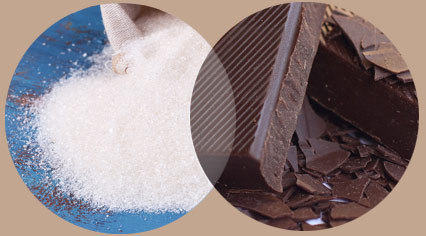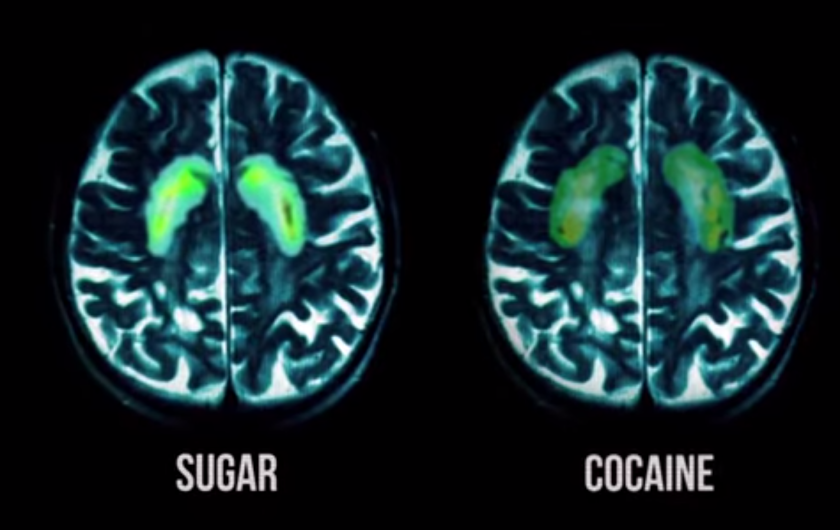
Sugar kills more Americans than cocaine and heroin
According to the latest scientifc and medical research, sugar is similarly addictive, more deadly and more socially harmful than cocaine. In the years to come, as this evidence becomes more undeniable (in a Daubert sense), it will be ammunition to tort lawyers to sue industrial manufactuers of chocolate (and more so, manufacturers of sugary beverages) for their use of sugar, to the same extent that they sued tobacco manufacturers for their use of the even more deadly, addictive, and harmful nicotine. There will be no choice but to remove the sugar.
Según las últimas investigaciones médicas y científicas, el azúcar es similar en poder adictivo, más letal y socialmente más dañino que la cocaína. En los próximos años, cuando ésta evidencia se haga más extensiva, será una munición para los abogados de responsabilidad civil para demandar a los fabricantes industriales de chocolate por el uso de azúcar (y más aún, los fabricantes de bebidas azucaradas), en la misma medida que demandaron a los fabricantes de tabaco por el uso de la más mortífera, adictiva y dañina nicotina. No habrá más remedio que retirar el azúcar.
The following chart has profound challenges for the chocolate industry.
Commonly Consumed
SubstanceDeaths
(U.S., per year)Lethality Treatment Costs
(U.S., per year)Addictiveness Social Harm Nicotine
(and a pesticide)480,000
(2014, CDC)
($500+ billion global sales)Most Deadly $300+ Billion
(2014, CDC)Most Addictive
(not UNODC/DEA regulated)Most Harmful Alcohol
(fermented sugar)
One of the most effective treatments for alcohcol addiction is naltrexone, used to treat heroin and opioid addiction.88,000
(2008, CDC)
($800+ billion global sales)↓ $223 Billion
(2006, CDC)↓
Very Addictive
(not UNODC/DEA regulated)↓ Alcohol
(binge drinking)↓ $245 Billion
(2010, CDC)↓
(not UNODC/DEA regulated)↓ Oxycontin & heroin, (il)legal opioids 40,000
(2016, CDC)
(legal - $10 billion global sales)
(illegal - $65 billion global sales)↓ < $78 Billion
()2013comparable
to nicotine↓ Sugar* 69,000
(diabetes)
(2000, ADA)↓ $245 Billion
(2013, ADA)↓
(not UNODC/DEA regulated)50,000+
(LE Amputations)
(2007, ADA)Sugary Drinks 25,000
(2015, Tufts)
($400+ billion global sales)↓ ↓
(not UNODC/DEA regulated)↓ Cocaine* 10,600
(2016, CDC)
($90+ billion global sales)↓ < $5 Billion
(est.)comparable
to sugar↓ ↓ ↓ ↓ ↓ ↓ ↓ Marijuana < 40
(CDC)↓ < $100 million
(est.)comparable
to sugar↓ Caffeine < 100
(2013, CDC)↓ < $1 million
(est.)↓
(not UNODC/DEA regulated)↓ ↓ ↓ ↓ Coca Leaf Extract 0 Not Deadly $0 million
(WHO, 1995)Not Addictive Harmless
"*": sugar is listed as more addictive than cocaine, for two reasons: social cost correlations (i.e., the more addictive a consumed substance is, the more deaths and treatment costs people will suffer for the pleasure, which is why nicotine is the world's most deadly and addictive narcotic in the SCoND sense), and scientific research. Please reference the following scientific studies:
"Intense sweetness surpasses cocaine reward", M. Lenoir, et al., PLoS ONE, August 2007, journals.plos.org/plosone/article?id=10.1371/journal.pone.0000698;
"Evidence for sugar addiction: behavioral and neurochemical effects of intermittent, excessive sugar intake", N. Avena et al., Neurosci Biobehav Review, 2008 v1, 20-39, www.ncbi.nlm.nih.gov/pmc/articles/PMC2235907/;
"Animal models of sugar and fat bingeing: relationship to food addiction and increased body weight", N. Avena et al., Methods Mol Biol, v 829, 2012, 351-65, www.ncbi.nlm.nih.gov/pubmed/?term=22231826;
"Food addictions to fat and sugar similar to cocaine and heroin in brain response",National Monitor, Beth Balen, 12 December 2014 (referencing article in the Am. Journal of Clinical Nutrition, http://natmonitor.com/2014/12/12/food-addictions-to-fat-and-sugar-similar-to-cocaine-and-heroin-in-brain-response/);
"Medicines used to treat nicotine addiction can be used to treat excess sugar consumption", Masroor Shariff et al., PLoS One, March 2016, journals.plos.org/plosone/article?id=10.1371/journal.pone.0150270;
"Differences in bingeing behavior and cocaine reward following intermittent access to sucrose, glucose or fructose solutions", JM Rorabaugh et al., Neuroscience, June 2015, 213-220, http://www.ncbi.nlm.nih.gov/pubmed/26079112;
"Who Will Run the Future of the US Pharma Market: Generic Or Branded Drugs?", Dr. Drew M. Fehsenfeld, https://terrace-healthcare.com/news/run-the-future-generic-or-branded.html;
"A higher ratio of fructose to glucose in sugar makes sugar more addictive", A Levy et al., Nutrients, May 2015, 3869-90, http://www.ncbi.nlm.nih.gov/pubmed/26007337;
"Sugar addiction: pushing the drug-sugar analogy to the limit", SH Ahmed et al.,Curr Opin Clin Nutr Metab Care, July 2013, 434-9, http://www.ncbi.nlm.nih.gov/pubmed/23719144; and
"Sugary drinks linked to 180,000 deaths a year", Gitanjali Singh et al., Circulation, June 2015, http://circ.ahajournals.org/content/early/2015/06/25/CIRCULATIONAHA.114.010636.
El azúcar aparece como más adictiva que la cocaína, por dos razones, las correlaciones de costo social (p.e. la sustancia más consumida y adictiva es, la que más muertes y costos de tratamiento sufre la gente por placer, la que es la nicotina, es por eso porque la nicotina es el narcótico más mortal y adictivo en el sentido SCoND), y las investigaciones científicas.
And what happens to your brain when you consume too much added sugar in these chocolates? ¿Y qué le pasa a su cerebro cuando se consume demasiado azúcar añadido en estos chocolates?

In short, it is time that the chocolate industry eliminates all uses of sugars and artificial sweeteners (which have their health dangers as well).
Contact KukaXoco via email or 415-981-0441 (U.S.)